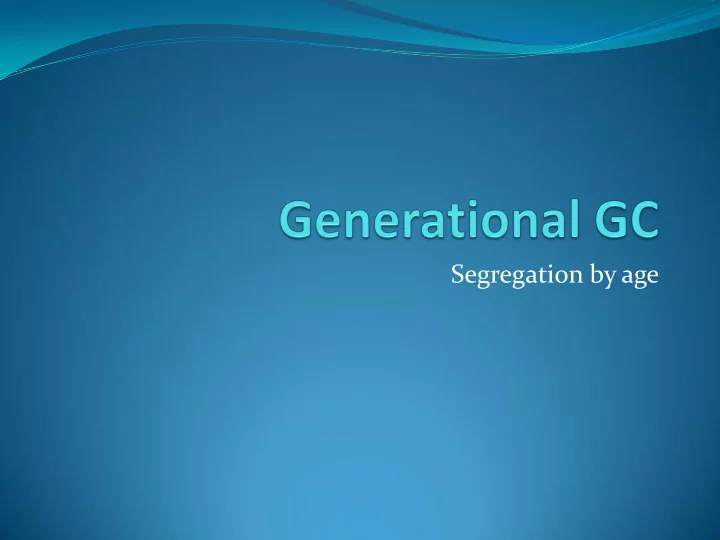

Segregation by age
Why generational garbage collection Simple tracing collectors suffer from a # of drawbacks All active data must be marked or copy Delays caused by GC can be obtrusive Deferred RC can be used to smooth out cost of GC But has high CPU overhead and cannot reclaim cycles Spend much time dealing with long-lived objects Repeatedly copies or marks Role of GC? To reclaim garbage Improve locality of system Interact well with virtual memory and cache 2
Weak generational hypothesis Lifetime of many objects is short Studies have shown that as high as 98% of objects can become garbage between GC cycles Weak generational hypothesis Most objects die young [Ungar, 1984] Insights Concentrate efforts on collecting young objects 3
Weak generational hypothesis Benefits: Collect only a part of the heap Pause time diminish GC becomes feasible for interactive systems “Can I garbage collect while tracking the mouse?” Avoid repeatedly processing objects that remain alive Overall effort of GC can be reduced Locality of the collector can be improved 4
Weak generational hypothesis Cost: System must be able to distinguish old from young objects Cost associated with storing in old object pointer to young object can be very expensive 5
Generational strategy Segregate objects by age into 2 or more regions in heap Each is called a generation Number of generations varies with implementation One scheme: vary number of generations dynamically Collect different generations at different frequencies Collect young generation most frequently Minor collection Collect older generations least frequently Major collection 6
Impact of generational GC Often used with incremental collection schemes Generational techniques have been very successful Use is widespread All commercial Lisps Modula-3, Glasgow Haskell, commercial SmallTalk systems For many applications today is collection system of choice 7
How does generational GC work? Objects first allocated in youngest generation Objects promoted to older generation if they survive long enough Youngest generation collected most frequently Weak generational hypothesis Promote objects to older generation After # of minor collections collect older generation Eliminate tenured garbage Collect younger generation when you collect older generation If more than 2 generations, promote objects to even older generation 8
A simple example C root A D set Young B E F Old G 9
Collect young generation root A set Young B F Old G 10
Promote survivors to old generation root set Young Tenured garbage F A Old B G 11
Allocate new object in young gen. root H set Young Tenured garbage F A Old B G 12
Properties of generational GC It is possible to collect younger generations without collecting older generations Young objects that survive # of minor collections promoted to older generation Minor collection successfully collect all short-lived objects in graph Inter-generational pointer (from G to B) G treated as part of root set for minor collection Garbage in older generation ( tenured garbage ) cannot be reclaimed by minor collection 13
Generational copy collector Youngest root set . From-space To-space . . Middle generation(s) Oldest From-space To-space 14
Other generational observations Can determine objects’ age by wall -clock-time or by growth rate due to allocation Strong generational hypothesis The older an object is the less likely it is to die Not generally true Advantages: Pauses for GC are shorter Less data to trace or copy at each collection Total volume of data moved throughout entire program is smaller Effective with short-lived objects 15
Inter-generational pointers Created in 2 ways storing pointers in object (assignment) Object containing pointers promoted to older gen. Burden on mutator or collector to track Promotion: can be easily tracked by collector Assignment: need write barrier to trap and record Recall most stores are in local variables Only need to record old-young pointers, Why? They are rare They become roots for minor collection 16
Recommend
More recommend